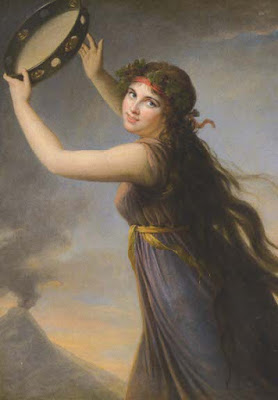More purchases from museum and exhibition gift shops...
1) FUNERAL DE SAN ANTONIO ABAD (1426-1430) - Fra AngelicoThe picture is so small I wonder how it took four years to complete! What I like about it is the formality of the composition and the hushed sadness in the huddled monks. In close-up the monks wail and whisper among themselves at their Abbot's passing while behind them the monastery stands tall, it's white walls nicely complemented by the blue sky and solitary tree.
2) THE CONVERSION OF ST PAUL (1600-1601) - Michelangelo Caravaggio
As usual, Caravaggio lights his subject from a single source which illuminates the stricken figure of St Paul who saw a blinding light on the road of Damascus which made him fall from his horse; he then heard the voice of Christ telling him to stop persecuting his followers and to become one himself. Paul stretches his arms out in the direction of the light while his servant tries to calm the horse from which Paul has fallen. The horse's massive looming flank and raised hoof are dynamically captured as your eyes follow the arrangement of limbs around the painting.
3) LADY HAMILTON AS A BACCHANTE (1792) - Élizabeth Vigée Le Brun
This was bought at the Grand-Palais in Paris which, astonishingly, held the first ever retrospective of Élizabeth Vigée Le Brun in 2015, 163 years after her death. Le Brun had been Marie-Antoinette's favourite portrait painter so when the French Revolution flared up, Le Brun escaped France with her young daughter rather than face certain death. She travelled to Italy, Austria and Russia, her association with the French aristocracy gaining her wealthy clients. In Naples, visiting Queen Maria Carolina - Marie-Antoinette's sister - she met the Queen's friend Emma Hart, mistress of the British Envoy Sir William Hamilton.
Élizabeth attended one of Emma's 'attitudes' evenings where she would pose in tableaux of classical paintings. This resulted in her posing for a number of portraits, all of a classical nature in which Le Brun captured Emma's legendary beauty. This portrait was painted in 1792, a year after Emma's marriage to Sir William Hamilton, and shows Emma as a wild Bacchante dancing in front of a smoking Vesuvius which Lady Hamilton could see from her villa. Demure yet abandoned, Emma dances with her tambourine, her hair tumbling and her Empire line dress clinging to her. While Le Brun appreciated Emma's beauty she disliked her personally. It was in the following year that Emma met Nelson and the rest, as they say, is history...
4) LES VESSENOTS EN AUVERS (1890) - Vincent Van Gogh
5) MARY, QUEEN OF SCOTS (c. 1610-1615) - Unknown





No comments:
Post a Comment